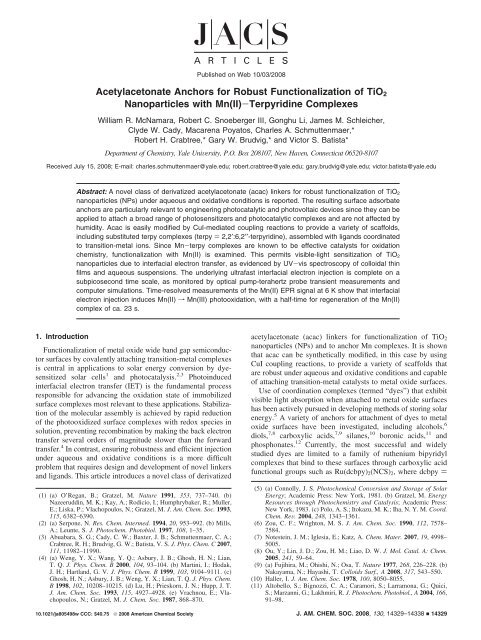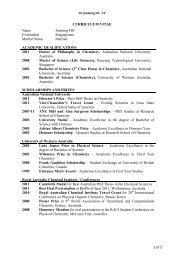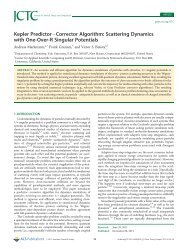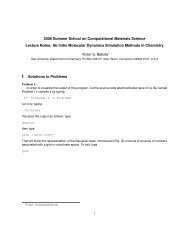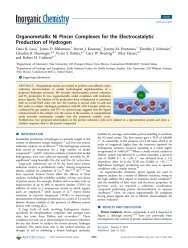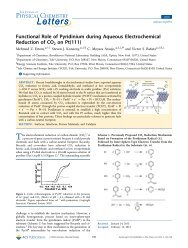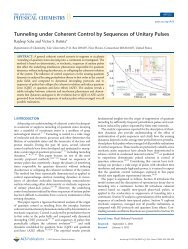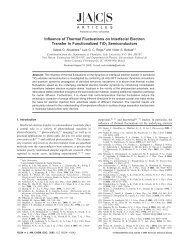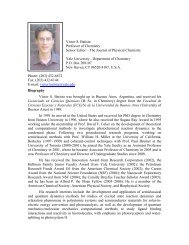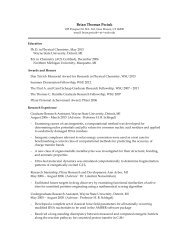J. Am. Chem. Soc. (2008) 130: 14329-14338 - American Chemical ...
J. Am. Chem. Soc. (2008) 130: 14329-14338 - American Chemical ...
J. Am. Chem. Soc. (2008) 130: 14329-14338 - American Chemical ...
- No tags were found...
Create successful ePaper yourself
Turn your PDF publications into a flip-book with our unique Google optimized e-Paper software.
Published on Web 10/03/<strong>2008</strong>Acetylacetonate Anchors for Robust Functionalization of TiO 2Nanoparticles with Mn(II)-Terpyridine ComplexesWilliam R. McNamara, Robert C. Snoeberger III, Gonghu Li, James M. Schleicher,Clyde W. Cady, Macarena Poyatos, Charles A. Schmuttenmaer,*Robert H. Crabtree,* Gary W. Brudvig,* and Victor S. Batista*Department of <strong>Chem</strong>istry, Yale UniVersity, P.O. Box 208107, New HaVen, Connecticut 06520-8107Received July 15, <strong>2008</strong>; E-mail: charles.schmuttenmaer@yale.edu; robert.crabtree@yale.edu; gary.brudvig@yale.edu; victor.batista@yale.eduAbstract: A novel class of derivatized acetylacetonate (acac) linkers for robust functionalization of TiO 2nanoparticles (NPs) under aqueous and oxidative conditions is reported. The resulting surface adsorbateanchors are particularly relevant to engineering photocatalytic and photovoltaic devices since they can beapplied to attach a broad range of photosensitizers and photocatalytic complexes and are not affected byhumidity. Acac is easily modified by CuI-mediated coupling reactions to provide a variety of scaffolds,including substituted terpy complexes (terpy ) 2,2′:6,2′′-terpyridine), assembled with ligands coordinatedto transition-metal ions. Since Mn-terpy complexes are known to be effective catalysts for oxidationchemistry, functionalization with Mn(II) is examined. This permits visible-light sensitization of TiO 2nanoparticles due to interfacial electron transfer, as evidenced by UV-vis spectroscopy of colloidal thinfilms and aqueous suspensions. The underlying ultrafast interfacial electron injection is complete on asubpicosecond time scale, as monitored by optical pump-terahertz probe transient measurements andcomputer simulations. Time-resolved measurements of the Mn(II) EPR signal at 6 K show that interfacialelectron injection induces Mn(II) f Mn(III) photooxidation, with a half-time for regeneration of the Mn(II)complex of ca. 23 s.1. IntroductionFunctionalization of metal oxide wide band gap semiconductorsurfaces by covalently attaching transition-metal complexesis central in applications to solar energy conversion by dyesensitizedsolar cells 1 and photocatalysis. 2,3 Photoinducedinterfacial electron transfer (IET) is the fundamental processresponsible for advancing the oxidation state of immobilizedsurface complexes most relevant to these applications. Stabilizationof the molecular assembly is achieved by rapid reductionof the photooxidized surface complexes with redox species insolution, preventing recombination by making the back electrontransfer several orders of magnitude slower than the forwardtransfer. 4 In contrast, ensuring robustness and efficient injectionunder aqueous and oxidative conditions is a more difficultproblem that requires design and development of novel linkersand ligands. This article introduces a novel class of derivatized(1) (a) O’Regan, B.; Gratzel, M. Nature 1991, 353, 737–740. (b)Nazeeruddin, M. K.; Kay, A.; Rodicio, I.; Humphrybaker, R.; Muller,E.; Liska, P.; Vlachopoulos, N.; Gratzel, M. J. <strong>Am</strong>. <strong>Chem</strong>. <strong>Soc</strong>. 1993,115, 6382–6390.(2) (a) Serpone, N. Res. <strong>Chem</strong>. Intermed. 1994, 20, 953–992. (b) Mills,A.; Leunte, S. J. Photochem. Photobiol. 1997, 108, 1–35.(3) Abuabara, S. G.; Cady, C. W.; Baxter, J. B.; Schmuttenmaer, C. A.;Crabtree, R. H.; Brudvig, G. W.; Batista, V. S. J. Phys. <strong>Chem</strong>. C 2007,111, 11982–11990.(4) (a) Weng, Y. X.; Wang, Y. Q.; Asbury, J. B.; Ghosh, H. N.; Lian,T. Q. J. Phys. <strong>Chem</strong>. B 2000, 104, 93–104. (b) Martini, I.; Hodak,J. H.; Hartland, G. V. J. Phys. <strong>Chem</strong>. B 1999, 103, 9104–9111. (c)Ghosh, H. N.; Asbury, J. B.; Weng, Y. X.; Lian, T. Q. J. Phys. <strong>Chem</strong>.B 1998, 102, 10208–10215. (d) Lu, H.; Prieskorn, J. N.; Hupp, J. T.J. <strong>Am</strong>. <strong>Chem</strong>. <strong>Soc</strong>. 1993, 115, 4927–4928. (e) Vrachnou, E.; Vlachopoulos,N.; Gratzel, M. J. <strong>Chem</strong>. <strong>Soc</strong>. 1987, 868–870.acetylacetonate (acac) linkers for functionalization of TiO 2nanoparticles (NPs) and to anchor Mn complexes. It is shownthat acac can be synthetically modified, in this case by usingCuI coupling reactions, to provide a variety of scaffolds thatare robust under aqueous and oxidative conditions and capableof attaching transition-metal catalysts to metal oxide surfaces.Use of coordination complexes (termed “dyes”) that exhibitvisible light absorption when attached to metal oxide surfaceshas been actively pursued in developing methods of storing solarenergy. 5 A variety of anchors for attachment of dyes to metaloxide surfaces have been investigated, including alcohols, 6diols, 7,8 carboxylic acids, 7,9 silanes, 10 boronic acids, 11 andphosphonates. 12 Currently, the most successful and widelystudied dyes are limited to a family of ruthenium bipyridylcomplexes that bind to these surfaces through carboxylic acidfunctional groups such as Ru(dcbpy) 2 (NCS) 2 , where dcbpy )(5) (a) Connolly, J. S. Photochemical ConVersion and Storage of SolarEnergy; Academic Press: New York, 1981. (b) Gratzel, M. EnergyResources through Photochemistry and Catalysis; Academic Press:New York, 1983. (c) Polo, A. S.; Itokazu, M. K.; Iha, N. Y. M. Coord.<strong>Chem</strong>. ReV. 2004, 248, 1343–1361.(6) Zou, C. F.; Wrighton, M. S. J. <strong>Am</strong>. <strong>Chem</strong>. <strong>Soc</strong>. 1990, 112, 7578–7584.(7) Notestein, J. M.; Iglesia, E.; Katz, A. <strong>Chem</strong>. Mater. 2007, 19, 4998–5005.(8) Ou, Y.; Lin, J. D.; Zou, H. M.; Liao, D. W. J. Mol. Catal. A: <strong>Chem</strong>.2005, 241, 59–64.(9) (a) Fujihira, M.; Ohishi, N.; Osa, T. Nature 1977, 268, 226–228. (b)Nakayama, N.; Hayashi, T. Colloids Surf., A <strong>2008</strong>, 317, 543–550.(10) Haller, I. J. <strong>Am</strong>. <strong>Chem</strong>. <strong>Soc</strong>. 1978, 100, 8050–8055.(11) Altobello, S.; Bignozzi, C. A.; Caramori, S.; Larramona, G.; Quici,S.; Marzanni, G.; Lakhmiri, R. J. Photochem. Photobiol., A 2004, 166,91–98.10.1021/ja805498w CCC: $40.75 © <strong>2008</strong> <strong>Am</strong>erican <strong>Chem</strong>ical <strong>Soc</strong>iety J. AM. CHEM. SOC. <strong>2008</strong>, <strong>130</strong>, <strong>14329</strong>–<strong>14338</strong> 9 <strong>14329</strong>
ARTICLESMcNamara et al.Figure 1. (a) Mn complex 1: [Mn II (H 2O) 3(catechol-terpy)] 2+ (terpy ) 2,2′:6,2′′-terpyridine). (b) Surface complex 1-TiO 2-NP. Color scheme: C (gray),H (white), Mn (purple), N (blue), O (red), Ti (green).(4,4′-dicarboxy-2,2′-bipyridine). This is also known as N719(also referred to as RuN3 or “red dye”) sensitized nanocrystallineTiO 2 thin films. 1 The carboxylic acid forms covalent bonds withthe TiO 2 surface that are stable in anhydrous conditions butundergo hydrolysis in aqueous environments. 14In recent work, we demonstrated visible-light sensitizationof TiO 2 nanoparticles by surface modification with Mn(II)-terpycoordination complexes (Figure 1) using catechol as a linker inaqueous environments. 3 We demonstrated that these Mn complexescan be photooxidized with visible light, using TiO 2nanoparticles as electron acceptors, bypassing the need toconsume any sacrificial oxidant. These findings are significantsince biomimetic oxomanganese complexes based on terpyridineligands can be tuned for water splitting, 15 or regio- andstereoselective oxidation of aliphatic CH bonds to form productssuch as alcohols and epoxides. 13 The demonstration of photooxidationof Mn complexes with visible light, therefore, isessential to bypass the need of primary oxidants and achievephotocatalytic oxidation chemistry based on TiO 2 thin filmsfunctionalized with Mn catalysts.Catecholate is a well-established rigid aromatic anchor thatstabilizes complex 1 attached to the TiO 2 surface, even inaqueous solutions (Figure 1). 3 It facilitates ultrafast electroninjection and concomitant Mn(II) f Mn(III) oxidation bylinking the Mn complex to the TiO 2 NP with favorable electroniccouplings and suitable positioning of electronic energy levels. 3However, the oxidizing power of the resulting Mn(III) complexand the possibility of advancing the oxidation state of thecomplex to higher valent states are limited by the relatively highelectronic states of catechol and the detrimental oxidationpathways, such as formation of ortho-quinone, shown in Figure2a.In this article, we explore derivatized acac scaffolds, specificallythe 2,4-pentanedionate linker substituted at the centralcarbon as depicted in Figure 2b. A somewhat similar β-ketoesteranchor was previously reported for a Ru(II) compound (with a2,2′-bipyridine attached with an n-propyl spacer; Figure S3 inthe Supporting Information) but provided a less stable linkagethan typical carboxylic acids, probably due to unfavorable(12) (a) Gallagher, L. A.; Serron, S. A.; Wen, X. G.; Hornstein, B. J.;Dattelbaum, D. M.; Schoonover, J. R.; Meyer, T. J. Inorg. <strong>Chem</strong>. 2005,44, 2089–2097. (b) Gillaizeau-Gauthier, I.; Odobel, F.; Alebbi, M.;Argazzi, R.; Costa, E.; Bignozzi, C. A.; Qu, P.; Meyer, G. J. Inorg.<strong>Chem</strong>. 2001, 40, 6073–6079.(13) Das, S.; Incarvito, C. D.; Crabtree, R. H.; Brudvig, G. W. Science2006, 312, 1941–1943.(14) (a) Weisz, A. D.; Regazzoni, A. E.; Blesa, M. A. Croat. <strong>Chem</strong>. Acta2007, 80, 325–332. (b) Weisz, A. D.; Regazzoni, A. E.; Blesa, M. A.Solid State Ionics 2001, 143, 125–<strong>130</strong>.(15) Chen, H. Y.; Tagore, R.; Das, S.; Incarvito, C.; Faller, J. W.; Crabtree,R. H.; Brudvig, G. W. Inorg. <strong>Chem</strong>. 2005, 44, 7661–7670.Figure 2. (a) Oxidation of catecholate to o-quinone. (b) Acetylacetonatescaffold.interactions between the surface and 2,2′-bipyridine whenattached to the β-ketoester via an n-propyl that is not derivatizingthe central carbon. 16 Therefore, it is important to investigatenew derivatized acac scaffolds. Acac is particularly attractivefor its ability to form stable coordination complexes withtitanium and other metal ions. 17 In particular, Ti(IV) coordinationcompounds have been extensively investigated in thecontext of precursors for TiO 2 synthesis 18 and are normallystable toward hydrolysis over a wide range of pH conditions. 19Acac also forms stable adducts with Ti(III) 20 and is expectedto be particularly robust during IET. In this article, weinvestigate these electronic and structural properties and provideevidence for the stability of acac-TiO 2 linkages in both aqueousconditions and in the presence of a strong oxidant.We focus on [Mn II (H 2 O) 3 (2)] 2+ , where 2, shown in Scheme1, is a phenylterpyridine ligand attached to 3-phenyl-acac viaan amide bond. The aromatic phenyl substituent on the acacanchor is specifically designed to optimize the rates of IET whenlinking transition-metal complexes to TiO 2 surfaces. The resultingstability in aqueous solutions and under oxidative conditionsis expected to be particularly suitable for the accumulation ofoxidizing equivalents at the Mn center, without degradationthrough oxidation pathways. We show that photoexcitation of[Mn II (H 2 O) 3 (2)] 2+ bound to TiO 2 induces Mn(II) f Mn(III)photooxidation, as probed by EPR at 6 K. Similarly, theregeneration of the Mn(II) complex is monitored by timeresolvedmeasurements of the Mn(II) EPR signal upon blockingthe illumination. We also analyze the time scale and reactionmechanism for the underlying ultrafast IET as observed byterahertz (THz) spectroscopy and computer simulations ofquantum electronic relaxation. Our results show that thisderivatized acac anchor can be used effectively for robustfunctionalization of colloidal TiO 2 NPs and for activating aMn(II) complex via photoexcitation and IET.2. Experimental and Computational ProceduresSample preparation and experimental procedures are describedbelow. All reagents not specifically mentioned were purchased fromAldrich and used without further purification. Ligand synthesis wasperformed using standard Schlenk techniques under N 2 atmosphere.(16) Heimer, T. A.; Darcangelis, S. T.; Farzad, F.; Stipkala, J. M.; Meyer,G. J. Inorg. <strong>Chem</strong>. 1996, 35, 5319–5324.(17) (a) Kessler, V. G.; Gohil, S.; Parola, S. Dalton Trans. 2003, 544–550. (b) Fackler, J. P. Prog. Inorg. <strong>Chem</strong>. 1966, 7, 361–378.(18) (a) Hollingsworth, N.; Kanna, M.; Kociok-Kohn, G.; Molloy, K. C.;Wongnawa, S. Dalton Trans. <strong>2008</strong>, 631–641. (b) Kim, Y. T.; Park,Y. S.; Myung, H.; Chae, H. K. Colloids Surf., A <strong>2008</strong>, 313, 260–263.(19) Sanchez, C.; Babonneau, F.; Doeuff, S.; Leaustic, A. UltrastructureProcessing of AdVanced Ceramics; Wiley: New York, 1988.(20) (a) Figgs, B. N.; Lewis, J.; Mabbs, F. J. <strong>Chem</strong>. <strong>Soc</strong>. 1963, 2473–2476. (b) Cox, M.; Lewis, J.; Nyholm, R. S. J. <strong>Chem</strong>. <strong>Soc</strong>. 1965, 2840–2844.14330 J. AM. CHEM. SOC. 9 VOL. <strong>130</strong>, NO. 43, <strong>2008</strong>
Functionalization of TiO 2 NPs with Mn ComplexesARTICLESScheme 1. Synthesis of Compounds 2 and 3The 1 H and 13 C NMR spectra were obtained using Brukerspectrometers operating at 400 and 500 MHz, respectively. <strong>Chem</strong>icalshifts are reported in ppm with the residual solvent as an internalreference. The molecules 3-[4-benzoic acid]pentane-2,4-dione (3) 21and 4′-p-aminophenyl-2,2′:6′,2′′-terpyridine (4) were synthesizedaccording to literature procedures as shown in Scheme 1. 13Dichloromethane was dried with a solvent purification system usinga 1-m column containing activated alumina. All the other solventswere used as received. The Degussa P25 TiO 2 25-nm nanoparticleswere 70% anatase and 30% rutile.2.1. Synthesis of 3-[4-Benzoic acid]pentane-2,4-dione (3).Compound 3 was synthesized according to the procedure reportedin the literature. 21 A mixture of 4-iodobenzoic acid (1.5 mmol),2,4-pentanedione (4.5 mmol), K 2 CO 3 (7.5 mmol), CuI (0.15 mmol),and L-proline (0.3 mmol) in 15 mL of DMSO was heated at 90 °Cunder nitrogen atmosphere for 24 h. The cooled solution was pouredinto 1 M HCl and extracted with ethyl acetate. The organic layerwas dried over MgSO 4 , and the solvent was removed under vacuum.The crude oil was purified on a silica gel column, using a mixtureof hexane/ethyl acetate (1:1) as eluent, to afford 205 mg of 3 (70%yield). 1 H NMR (CDCl 3 , 400 MHz): (100% enol form) 16.65 (s,1H, OH), 8.08 (d, 3 J H-H ) 8 Hz, 2H, CH Ar ), 7.25 (d, 3 J H-H ) 8Hz, 2H, CH Ar ), 1.84 (s, 6H, CH 3 ). 13 C NMR (CDCl 3 , 75 MHz):190.7 (C-OH), 171.7 (COOH), 142.8 (C Ar ), 131.4 (CH Ar ), <strong>130</strong>.8(CH Ar ), 128.6 (C Ar ), 114.5 (C Enol ), 24.2 (CH 3 ). MS: ES molecularion calcd for C 12 H 12 O 4 H + , 221.080835; found, m/z ) 221.08083.2.2. Synthesis of 2. Thionyl chloride (0.38 mmol) was addeddropwise to a solution of 3-[4-benzoic acid]pentane-2,4-dione (3,0.255 mmol) in dichloromethane (5 mL), and the resulting mixturewas refluxed for 3 h. Afterward, the volatiles were removed bybubbling N 2 through the solution. Five milliliters of dry dichloromethaneand N,N′-diisopropylethylamine (0.31 mmol) was subsequentlyadded, and the resulting mixture was stirred at roomtemperature for 10 min. 4′-p-<strong>Am</strong>inophenyl-2,2′:6′,2′′-terpyridine (4,0.255 mmol) was added in 2 mL of dry dichloromethane, and theorange solution was heated for 24 h. The cooled solution was pouredinto the same amount of water and extracted with ethyl acetate.The organic layer was washed with an aqueous saturated solutionof NaHCO 3 and dried over MgSO 4 . Upon removal of the volatiles,the oily residue was purified by column chromatography on silicagel. Elution with a 1% MeOH solution in dichloromethane affordedthe separation of a colorless band containing compound 2. Further(21) Jiang, Y. W.; Wu, N.; Wu, H. H.; He, M. Y. Synlett 2005, 2005, 2731–2734.elution with a 1% MeOH solution in ethyl acetate afforded theseparation of an orange band also containing 2 (60% yield). 1 HNMR (CDCl 3 , 400 MHz): % enol (100%) 14.41 (s, 1H, OH), 8.66(m, 2H, H 5 ), 8.64 (s, 2H, H 1 ), 8.58 (d, 2H, 3 J H-H ) 8 Hz, H 2 ),8.19 (br s, 1H, NH), 7.85-7.74 (8H, CH Ar + H 3 ), 7.27 (qd, 2H,3 J H-H ) 7.6 Hz, 4 J H-H ) 1.2 Hz, H 4 ), 7.22 (d, 3 J H-H ) 8.4 Hz,CH Ar ), 1.81 (s, 6H, CH 3 ). 13 C NMR (CDCl 3 , 125 MHz): δ 189.7(C-OH), 164.3 (CONH), 155.2 (C 11 ), 155.9 (C 12 ), 148.4 (C 9 ), 148.1(C 16 ), 139.9 (C 1 ), 137.8 (C 5 ), 135.9 (C 14 ), 133.4 (C 8 ), 133.1 (C 4 ),<strong>130</strong>.6, 127.1, 126.7 (CH Ar ), 122.8 (C 13 ), 120.4 (C 15 ), 119.4 (C 6 ),117.4 (C 10 ), 113.3 (C Enol ), 13.2 (CH 3 ). MS: ES molecular ion calcdfor C 33 H 26 N 4 O 3 H + , 527.207767; found, m/z ) 527.20636.2.3. Sensitization of TiO 2 with Complex 2. The samples fortime-resolved EPR studies were prepared by stirring 15 mg ofDegussa P25 TiO 2 nanoparticles in 2 mL of a 0.9 mM solution of2 (9.5 mg, 0.018 mmol) in dichloromethane at reflux for 2 h. Theresulting suspension was allowed to cool to room temperature andcentrifuged to pellet the sensitized nanoparticles. The supernatantwas then decanted, and the remaining particles were washed withdichloromethane. The stability of the acac linker was establishedby exposing the sensitized nanoparticles to an aqueous solution ofpotassium peroxymonosulfate (oxone). The oxidant did not releasethe ligand over 5 h.2.4. Preparation of Mesoporous Thin Films of SensitizedTiO 2 . The samples for time-resolved THz and UV-vis spectroscopicmeasurements consist of thin mesoporous films (∼10-µmthick) of Degussa P25 TiO 2 nanoparticles. The nanoparticles weredoctor-bladed from aqueous solution onto a glass coverslip andannealed at 360 °C for 30 min. The resulting slides were sensitizedwith 2 by refluxing in 60 mL of a 0.03 mM solution (9.5 mg, 0.018mmol) of 2 in dry dichloromethane for 2 h. The resulting sensitizedfilms were rinsed with dry dichloromethane before analysis.Thin films sensitized with [Mn II (H 2 O) 3 (2)] 2+ were prepared byrinsing films sensitized with 2 with deionized water and thensoaking in a2mMaqueous solution of Mn(II) acetate for 12 h.2.5. UV-vis, FTIR, and Powder X-ray Diffraction Measurements.Films of P25 nanoparticles were highly scattering, andspectra were obtained with a Varian Cary 3 spectrophotometer indiffuse reflectance geometry using an integrating sphere. Nanoparticlesprepared by one of the numerous sol-gel methods couldprovide films of better quality. Reported spectra of nanoparticlefilms were taken using an NP film on a microscope slide coverslipcovered with a drop of pH-neutral deionized water and then witha second coverslip. The baseline spectrum of a coverslip wasJ. AM. CHEM. SOC. 9 VOL. <strong>130</strong>, NO. 43, <strong>2008</strong> 14331
ARTICLESsubtracted and only absorbs at wavelengths less than 350 nm. Dry,uncovered samples were also measured and show similar behavior.Diffuse reflectance infrared Fourier transform spectra wererecorded on a Nicolet 6700 infrared spectrophotometer equippedwith a DTGS detector and a Nexus Smart Collector. Samples werecollected as dry materials and measured in KBr matrix. Typically,128 scans were performed for each spectrum. The resolution was2cm -1 . Analogous FTIR methods were previously applied tocharacterize the binding of carboxylate linkers onto Degussa P25titania. 22The powder X-ray diffraction (XRD) patterns of the sampleswere recorded on a Bruker-AXS D8 Focus diffractometer (λ )1.5418 Å Cu KR radiation, step time 1 s) over the range of 20°
Functionalization of TiO 2 NPs with Mn ComplexesFigure 3. Comparison of relaxed configurations of model nanostructuresof TiO 2-anatase sensitized with: (a) acac anchored to the (101) surface bybridging two Ti 4+ ions, (b) bidentate chelating a single Ti 4+ , (c) monodentatebinding to a Ti 4+ center, and (d) bidentate chelating a single Ti 4+at an oxygen vacancy. The binding energies for (a-d) are 42, 12, 47, and68 kcal/mol, respectively. Green represents Ti 4+ ions, red represents O 2-ions, light blue represents C atoms, and small gray spheres represent Hatoms.2.10.3. Functionalized Anatase: Electronic Structure Calculations.The description of the electronic structure of[Mn II (H 2 O) 3 (2)] 2+ -NP is based on tight-binding model Hamiltoniansusing the semiempirical extended Hückel (EH) approach, withperiodic boundary conditions as implemented in previous work. 3,33-36It was shown that the method requires a relatively small numberof transferable parameters and is capable of providing accurateresults for the energy bands of elemental materials (includingtransition metals) as well as compound bulk materials in variousphases. 37 The EH method is applicable to large extended systemsand, contrary to plane-wave basis set approaches, provides valuableinsight on the role of chemical bonding. 36 The method is, therefore,(32) Frisch, M. J.; Trucks, G. W.; Schlegel, H. B.; Scuseria, G. E.; Robb,M. A.; Cheeseman, J. R.; Montgomery, J. A., Jr.; Vreven, T.; Kudin,K. N.; Burant, J. C.; Millam, J. M.; Iyengar, S. S.; Tomasi, J.; Barone,V.; Mennucci, B.; Cossi, M.; Scalmani, G.; Rega, N.; Petersson, G. A.;Nakatsuji, H.; Hada, M.; Ehara, M.; Toyota, K.; Fukuda, R.; Hasegawa,J.; Ishida, M.; Nakajima, T.; Honda, Y.; Kitao, O.; Nakai, H.; Klene,M.; Li, X.; Knox, J. E.; Hratchian, H. P.; Cross, J. B.; Bakken, V.;Adamo, C.; Jaramillo, J.; Gomperts, R.; Stratmann, R. E.; Yazyev,O.; Austin, A. J.; Cammi, R.; Pomelli, C.; Ochterski, J. W.; Ayala,P. Y.; Morokuma, K.; Voth, G. A.; Salvador, P.; Dannenberg, J. J.;Zakrzewski, V. G.; Dapprich, S.; Daniels, A. D.; Strain, M. C.; Farkas,O.; Malick, D. K.; Rabuck, A. D.; Raghavachari, K.; Foresman, J. B.;Ortiz, J. V.; Cui, Q.; Baboul, A. G.; Clifford, S.; Cioslowski, J.;Stefanov, B. B.; Liu, G.; Liashenko, A.; Piskorz, P.; Komaromi, I.;Martin, R. L.; Fox, D. J.; Keith, T.; Al-Laham, M. A.; Peng, C. Y.;Nanayakkara, A.; Challacombe, M.; Gill, P. M. W.; Johnson, B.; Chen,W.; Wong, M. W.; Gonzalez, C.; Pople, J. A. Gaussian 03, revisionC.02; Gaussian, Inc.: Wallingford, CT, 2004.(33) Rego, L. G. C.; Batista, V. S. J. <strong>Am</strong>. <strong>Chem</strong>. <strong>Soc</strong>. 2003, 125, 7989–7997.(34) Abuabara, S. G.; Rego, L. G. C.; Batista, V. S. J. <strong>Am</strong>. <strong>Chem</strong>. <strong>Soc</strong>.2005, 127, 18234–18242.(35) (a) Rego, L. G. C.; Abuabara, S. G.; Batista, V. S. J. <strong>Chem</strong>. Phys.2005, 122, 154709. (b) Rego, L. G. C.; Abuabara, S. G.; Batista, V. S.Quantum Inf. Comput. 2005, 5, 318–334. (c) Rego, L. G. C.; Abuabara,S. G.; Batista, V. S. J. Mod. Opt. 2006, 53, 2519–2532.(36) Hoffman, R. ReV. Mod. Phys. 1988, 60, 601–628.(37) Cerda, J.; Soria, F. Phys. ReV. B2000, 61, 7965–7971.ARTICLESmost suitable to develop a clear chemical picture of the relativepositioning of electronic energy levels, at the semiquantitative level,and the electronic couplings responsible for the IET mechanism. 3,33-352.10.4. Simulations of IET. We computed the survival probability,P(t), defined as the probability that the photoexcited electronremains in the adsorbate molecule at time t after excitation of thesystem. 33 P(t) characterizes the IET time scales and was obtainedas the projection of the time-evolved electronic wave function ontothe atomic orbitals (AOs) of the molecular adsorbate. Computingthe time-dependent wave function |Ψ(t)〉 ) ∑ i B i (t)|χ i 〉, expandedin the basis set of AOs |χ i 〉, required the propagation of theexpansion coefficients B i (t) ) ∑ q Q i q C q exp[-(i/p)E q t], where C qis the expansion coefficient of the initial state |Ψ(0)〉 ) ∑ q C q |q〉.The eigenvectors and eigenvalues Q q and E q were obtained bysolving the generalized EH eigenvalue problem, HQ q ) E q SQ q ,with H the EH Hamiltonian matrix. Here, S is the atomic orbitaloverlap matrix. Once the time-dependent wave function wasobtained, the survival probability was computed as follows: P(t)) |∑ i MOL ∑ j B i * (t)B j (t)S ij |. To avoid artificial recurrences inelectron-transient populations, the calculations of charge injectionwere conducted in models consisting of a 3 × 3 adsorbate-anatasesupercell array. Initial states are defined in terms of the excitedelectronic states of the adsorbate with significant electroniccouplings with the semiconductor conduction band.2.10.5. Simulations of UV-Vis Spectra. Figure 6 shows theUV-vis spectrum of the complex [Ti(phenyl-acac)(H 2 O) 4 ] 3+ ,asobtained at the TD-DFT/(LACVP, 6-31G) level of theory. Theinfinite resolution spectrum described by the oscillator strengthsof vertical transitions, associated with the complex in the groundstateminimum energy configuration, is compared to the spectrumconvoluted with a Gaussian function (fwhm ) 60 nm) to mimicinhomogeneous broadening induced by thermal nuclear fluctuations.Note that the phenyl-acac in such a model complex is acting as abidentate ligand, modeling adsorption at an oxygen vacancy (Figure3d). These calculations suggest that functionalization of TiO 2surfaces with phenyl-acac should lead to visible-light sensitizationdue to ligand-to-metal and intraligand transitions at λ < 550 nm.These electronic transitions are common to other Lewis baseanchors attached to TiO 2 (e.g., catechol 3 ) and can be exploited forabsorption of visible light even when the anchor/linker and the TiO 2surface absorb only in the UV region of the spectrum.3. ResultsThe results are presented in six subsections. First, we analyzethe acac-TiO 2 binding energy and configuration. Second, wecharacterize the density of electronic states. Third, we analyzethe stability of acac-TiO 2 surface complexes sensitizing TiO 2NPs in aqueous conditions, in an effort to investigate the stabilityof derivatized acac linkers in aqueous solutions as compared tocarboxylate linkers typically used in dye-sensitized solar cells.Fourth, we analyze the stability of the surface complexes underoxidative conditions. Fifth, we analyze the dynamics of ultrafastIET as characterized by THz spectroscopy and direct comparisonswith quantum dynamics simulations. Finally, the sixthsection characterizes the dynamics of photooxidation of the Mncenter induced by visible light, as probed by time-resolved EPRspectroscopy.3.1. Acac-Anatase Structure and Binding Energy. Figure 3shows relaxed configurations of TiO 2 -anatase nanostructures,functionalized with acac on the (101) surface, after fullyoptimizing the energy of the system with respect to the geometryof the anchored molecule and the six topmost layers of thesemiconductor surface. Our computational analysis was focusedon the (101) surface of anatase since the XRD analysis indicatesthat Degussa P25 is 85% anatase, with the large diffractioncontribution from the (101) surface. In addition, we also observeJ. AM. CHEM. SOC. 9 VOL. <strong>130</strong>, NO. 43, <strong>2008</strong> 14333
ARTICLESMcNamara et al.Figure 4. The Density of states (DOS) of the TiO 2 anatase nanostructurefunctionalized with phenyl-acac (a) and catechol (b), bridging between twoTi 4+ ions on the (101) surface. The filled solid curve represents the DOSprojected on the basis functions of the adsorbate. The Fermi energy E Findicates the HOMO of the system, while states E 1 and E 2 represent theexcited electronic states with a predominant contribution of the phenylacac-LUMOand phenyl-acac-(LUMO + 1), respectively. The distributionof eigenstates is convoluted with a Gaussian (fwhm ) 0.5 eV) to facilitatethe visualization of electronic energy bands.a predominant diffraction contribution from the (101) anatasesurface in amorphous and crystalline anatase synthesized bysol-gel methods (our XRD data is provided in the SupportingInformation and is consistent with recently reported studies 38 ).Four binding modes are compared, including (a) bridging twodifferent Ti 4+ ions on the (101) surface, (b) chelating a singleTi 4+ ion, (c) monodentate coordination to a single Ti 4+ ion,and (d) chelating a four-coordinate Ti 4+ ion at an oxygen defect.The binding energies are 42, 12, 47, and 68 kcal/mol, respectively.These calculations indicate that acac attaches stronglyto pristine (101) TiO 2 surfaces (i.e., no oxygen vacancy) whenanchored via the bridging mode (a) or the monodentatecoordination (c). Binding according to the chelating mode (b),however, is 30-35 kcal/mol less stable because of the resultingdisplacement of the anchoring Ti 4+ ion away from the (101)surface. However, these calculations find that the most stableattachment corresponds to acac adsorption to surface bridgebondedoxygen vacancies that are common surface defects inTiO 2 . 29,39 Figure 3d shows acac binding to such an oxygenvacancy site, chelating the four-coordinate Ti 4+ ion. It is shownthat the absence of the surface oxygen allows acac to form arobust six-membered ring with the Ti 4+ ion, without inducingsignificant structural rearrangements as observed in bindingmode (b) (Figure 3b).The calculated binding energies of acac in the variouscoordination modes suggest that, under low coverage conditions,acac must block surface oxygen vacancies, as a bidentate ligandto Ti 4+ ions as depicted in Figure 3d. At higher surfacecoverages, surface oxygen vacancies will be saturated and acacwill bind in modes (a) and (c) as depicted in Figure 3a,c,according to the bridging and monodentate coordination modes.Upon surface reconstruction, however, the coordination of acacis expected to change, stabilizing the formation of surfaceoxygen vacancies.3.2. Density of Electronic States. Figure 4 shows the comparisonof the DOS of TiO 2 anatase nanostructures functionalizedwith phenyl-acac and catechol linkers. 40 The filled solidcurve in Figure 4 represents the projected density of states onthe adsorbate basis functions, showing that strong Lewis basessuch as acac and catechol bind to the surface and introduce(38) Yeredla, R. R.; Xu, H. Nanotechnology <strong>2008</strong>, 19, 055706.(39) (a) Kim, Y. K.; Kay, B. D.; White, J. M.; Dohnalek, Z. Surf. Sci.<strong>2008</strong>, 602, 511–516. (b) Kim, Y. K.; Kay, B. D.; White, J. M.;Dohnalek, Z. Catal. Lett. 2007, 119, 1–4.Figure 5. Top: Schematic diagram of a TiO 2 NP functionalized with[Mn II (H 2O) 3(2)] 2+ , where the Mn complex is covalently attached to theTiO 2 surface by the phenyl-acac anchor. Bottom: Density of electronic states,convoluted with a Gaussian (fwhm ) 0.5 eV) to facilitate the visualizationof electronic energy bands. The arrows indicate the electron transferpathway, induced by photoexcitation and electron injection, leading to Mnoxidation. Favorable directionality of electron transfer is due to thepositioning of electronic energy levels in the electron donor and acceptorparts of the ligand-linker chromophore.electronic states in the semiconductor band gap. The Fermi levelof phenyl-acac/TiO 2 structure is lower than the correspondingstate in catechol/TiO 2 , suggesting that phenyl-acac/TiO 2 shouldbe more robust under oxidative conditions. Furthermore, thelower lying E 1 state in phenyl-acac/TiO 2 relative to that forcatechol/TiO 2 should allow for excited-state IET from a widerrange of molecular complexes. The additional electronic statesin the TiO 2 band gap lead to visible-light sensitization whenthey are optically coupled to the electronic states at the bottomof the conduction band (e.g., states with predominant contributionsfrom the 3d xz ,3d yz , and 3d xy orbitals of Ti 4+ ions directlycoordinating the adsorbate molecules). These interfacial electronicstate transitions lead to oxidation of the attached molecularcomplexes, as illustrated in Figure 5.Figure 5 shows that the excited electronic states of the[Mn II (H 2 O) 3 (2)] 2+ (e.g., the excited electronic states E 1 and E 2with predominant contributions of the phenyl-acac-LUMO andphenyl-acac-(LUMO + 1), respectively) overlap with theconduction band. These states can therefore mediate excitedstateIET when the anchoring complex is photoexcited. Thedensity of states and the component projections into basisfunctions of the linkers suggest that the phenyl-acac/TiO 2 surfaceshould be resistant to oxidation because of the low-lyingelectronic states, should allow for visible light sensitizationbecause of cross electronic transitions to the TiO 2 conductionband, and should lead to photooxidation of the attachedmolecular complexes because of the favorable relative positioningof the electronic energy levels.(40) (a) McGlynn, S. P.; Vanquickenborne, L. G.; Kinoshita, M.; Carroll,D. G. Introduction to Applied Quantum <strong>Chem</strong>istry; Holt, Rinehart,and Winston: New York, 1972. (b) Nalewajski, R. F.; Koster, A. M.;Bredow, T.; Jug, K. J. Mol. Catal. 1993, 82, 407–423. (c) Bredow,T.; Jug, K. Surf. Sci. 1995, 327, 398–408. (d) Bredow, T.; Jug, K. J.Phys. <strong>Chem</strong>. 1995, 99, 285–291. (e) Kormann, C.; Bahnemann, D. W.;Hoffmann, M. R. J. Phys. <strong>Chem</strong>. 1988, 92, 5196–5201.14334 J. AM. CHEM. SOC. 9 VOL. <strong>130</strong>, NO. 43, <strong>2008</strong>
Functionalization of TiO 2 NPs with Mn ComplexesARTICLESFigure 6. UV-vis spectrum of the complex [Ti(phenyl-acac)(H 2O) 4] 3+shown in the inset, obtained at the TD-DFT/(LACVP, 6-31G*) level oftheory.Figure 8. (a, b) UV-vis spectra of 2-TiO 2 and N719-TiO 2, respectively,after exposure to 2 mM oxone for 0 (black), 1 (blue), 3 (red), 6 (light green),and 24 (green) hours. Analogous spectra for terpy-catechol/TiO 2 areprovided in the Supporting Information. (c) Decrease in absorbance as afunction of time of TiO 2 thin films functionalized with N719 (red, measuredat 550 nm), catechol-terpy (black, measured at 450 nm), and 2 (blue,measured at 450 nm) due to exposure to 2 mM aqueous oxone.Figure 7. (a) Comparison of the UV-vis spectra of P25 TiO 2 NPssensitized with 2 (blue), N719 (red), and bare P25 TiO 2 (black). (b)Comparison of the amount of sensitizers that remained attached to TiO 2 asa function of time of incubation in water, based on the absorbance at timet relative to the initial absorbance (t ) 0). 450 and 550 nm were used asthe characteristic wavelengths for 2-TiO 2 (blue) and N719-TiO 2 (red),respectively.3.3. Water Stability Studies by UV-Vis Spectroscopy. Figure7a compares UV-vis spectra of [Mn II (H 2 O) 3 (2)] 2+ linked toP25 TiO 2 NPs with N719-sensitized TiO 2 NPs as well as bareTiO 2 NPs. Several spectra were collected after immersing thesamples in water for 0-24 h, and the absorbance at a specificwavelength for the dye-sensitized samples relative to that beforesoaking is shown in Figure 7b. Note that the absorbance of[Mn II (H 2 O) 3 (2)] 2+ linked to P25 TiO 2 NPs remains relativelyunchanged, even after being stirred in water for a period of 24 h.On the other hand, Figure 7b shows that the absorbance of theN719-sensitized TiO 2 NPs decreases significantly as a functionof time in water, reaching roughly 0.3 after 24 h. These resultsdemonstrate the detachment of carboxylate linkers from the TiO 2surface in the presence of water and that the acac linkage ishighly resistant to detachment under aqueous conditions.3.4. Stability under Oxidative Conditions. We comparedfunctionalized TiO 2 thin films before and after treatment witha 2 mM solution of aqueous oxone for 24 h. We found thatTiO 2 surfaces functionalized with derivatized acac were relativelyunaffected by aqueous oxone, indicating that the acac-TiO 2 linkage is robust under aqueous and oxidative conditions.In contrast, TiO 2 thin films functionalized with terpy-catecholligands and carboxylate linkers were significantly degraded whenexposed to oxone.Figure 8a,b show UV-vis spectra of 2- and N719-sensitizedTiO 2 thin films, respectively, after exposure to 2 mM oxoneFigure 9. (a) Schematic of possible electron injection pathways into TiO 2from bulk photoexcitation (1) or from photoexcitation of the sensitizer, S/S*(2 and 3). Electrons can also become trapped in TiO 2 (4) and recombinewith the oxidized sensitizer (5). Processes 1-3 decrease THz transmission,whereas 4 and 5 increase it. (b) 410-nm pump/THz probe of electroninjection in functionalized TiO 2 NP films of the following: N719 (red), 2(blue), and [Mn II (H 2O) 3(2)] 2+ (green).for 0-24 h. A shift in the absorption maximum of the N719-sensitized TiO 2 spectrum after exposure to 2 mM oxone for 1(blue), 3 (red), 6 (light blue), and 24 (green) hours suggestsdecomposition of the dye under aqueous oxidative conditions.No such spectral shift in absorbance is observed for 2-TiO 2 ,indicating robustness of 2. In addition, Figure 8c shows thedecrease in absorbance for TiO 2 NP thin films functionalizedwith N719 (red), catechol-terpy (black), and 2 (blue), as afunction of time exposure to 2 mM aqueous oxone. It is clearthat derivatized acac scaffolds are much more robust thancarboxylate and catechol linkers under prolonged exposure toaqueous oxidative conditions.3.5. Ultrafast Interfacial Electron Transfer. Since THz radiationis absorbed by free electrons in the TiO 2 conduction band,it is possible to compare the time scale and efficiency of chargeinjection into bare and functionalized TiO 2 NPs with subpicosecondtemporal resolution. 23,41 Photoexcitation and subsequentelectron injection causes the free carrier population in the TiO 2to increase, decreasing the THz transmission amplitude.Figure 9a shows possible electron injection pathways intoTiO 2 from bulk photoexcitation or from photoexcitation of thesensitizer, S/S*. There are three possible pathways for electronsto be injected into the TiO 2 conduction band since thephotoexcitation energy of the pump-pulse is near the band edgeof the TiO 2 . These include (1) direct photoexcitation of bulk(41) Schmuttenmaer, C. A. <strong>Chem</strong>. ReV. 2004, 104, 1759–1779.J. AM. CHEM. SOC. 9 VOL. <strong>130</strong>, NO. 43, <strong>2008</strong> 14335
ARTICLESTiO 2 , (2) direct transitions from the sensitizer into the TiO 2conduction band, and (3) photoexcitation of the sensitizer,followed by relaxation to the TiO 2 conduction band. In cases(2) and (3), the sensitizer could inject from orbitals localizedon the phenyl-acac part of the linker or from orbitals localizedin the Mn-terpy complex. Each of these pathways lead to thecreation of Mn(III), since even injection from the phenyl-acaclinker is followed by the subsequent oxidation of Mn(II) andlinker reduction by electron transfer as shown in Figure 5.Figure 9b shows ultrafast interfacial electron injection inducedby 410-nm photoexcitation of TiO 2 NP colloidal thin films,including bare TiO 2 , and TiO 2 NPs functionalized with[Mn II (H 2 O) 3 (2)] 2+ , 2, and N719. There is negligible THzabsorption from the bare TiO 2 sample, which is consistent withits negligible absorption at 410 nm. The magnitudes of thechanges in THz transmission through NP films sensitized witheach of the three adsorbates are essentially the same, whichconfirms charge injection from the photoexcited sensitizer viapathways (2) and/or (3). Although the transmission unit in Figure9b is arbitrary, the same scaling factor is used for all spectra,so amplitude comparisons are meaningful (i.e., no normalizationwas performed).The ultrafast spectroscopic data (Figure 9b) indicate that IETfrom the adsorbate to the NP is completed on a subpicosecondtime scale after photoexcitation of the system. The time-resolvedTHz injection data are well fit using a single exponential withtime constant of ∼300 fs convoluted with a Gaussian instrumentresponse function for each of the sensitizers. We note that 300fs actually represents an upper bound on the injection time scale,since this approaches the limit of the time resolution of ∼500fs for the spectrometer. Additionally, THz radiation is onlysensitive to mobile electrons. If injected electrons are initiallybound at surface sites 42 or exhibit low mobility before thermalizingwith the TiO 2 lattice, 43 they will be invisible or lessvisible to the THz probe. 24 The 300 fs should then correspondto the time for electrons to become highly mobile, while thetime scale for interfacial electron injection is probably muchfaster. THz measurements taken over hundreds of picosecondsdo not show any slower injection components for any of thesensitizers. However, we cannot exclude the possibility that thereare multiple time scales for injection from the various pathwaysmentioned previously, but that all time scales are equal to orfaster than our experimental resolution.Figure 9b also shows that the THz absorbance signal decaysexponentially with a half-life of ∼10 ps for each of the threesensitizers and then levels off. This indicates that the injectedelectrons get trapped at TiO 2 defects or surface sites orrecombine with oxidized adsorbates. However, the Mn(III)created by photooxidation of [Mn II (H 2 O) 3 (2)] 2+ could remainstable for much longer since the photogenerated electron andhole are no longer correlated. Previous experiments showrecombination in sensitized NP systems to occur on time scalesranging from picoseconds to milliseconds, 44 and the lifetimesof the electron and the Mn(III) are expected to depend stronglyon the composition of the solution surrounding the NP film.Figure 10 (top) shows the time-dependent adsorbate populationsobtained by solving the electronic time-dependent Schrödingerequation according to a mixed quantum-classical(42) Gundlach, L.; Ernstorfer, R.; Willig, F. Phys. ReV.B2006, 74, 035324.(43) Turner, G. M.; Beard, M. C.; Schmuttenmaer, C. A. J. Phys. <strong>Chem</strong>.B 2002, 106, 11716–11719.(44) Ramakrishna, G.; Ghosh, H. N. J. Phys. <strong>Chem</strong>. B 2001, 105, 7000–7008.McNamara et al.Figure 10. Top: Time-dependent adsorbate populations corresponding tophotoexcited surface complexes attached to a pristine (101) surface (black)or an oxygen vacancy (blue). Bottom: Snapshots of the electronic chargedistribution at 10 fs after initiating the IET from phenyl-acac attached to apristine (101) surface (a) or attached to an oxygen vacancy defect (b). Onlythe TiO 2 structure next to photoexcited adsorbate is shown for a detailedview of the Ti 4+ d orbitals localizing the injected charge during the earlytime IET.approach. 3,33,34 These transient adsorbate populations are obtainedby projecting the time-evolved electronic wave packetonto the atomic orbitals of the molecular adsorbate. These resultsindicate that typical electron injection events are completedwithin 50-100 fs for linkers attached to pristine surfaces oroxygen vacancies. These results are consistent with our THzspectroscopic measurements since the predicted time scale forelectron injection is shorter than the ∼500 fs instrument responsefunction.Figure 10 (bottom) shows the distribution of injected charge,at the molecular level, 10 fs after excitation of the [Mn II (H 2 O) 3 -(2)] 2+ -NP surface complex to a representative electronicexcited state that overlaps with electronic states in the semiconductorconduction band (see state E 1 in Figure 4). Severalother electronic states also play an important role in the processof electron injection, including states localizing the electronicexcitation around the anchoring site, and others localizing theexcitation around the phenyl, or terpy, moieties. Most of thesephotoactive states show similar early time relaxation leadingto depletion of electronic density in the linker and electroninjection into the d xz orbitals of Ti 4+ ions next to the surfacecomplex, followed by charge diffusion and surface-chargeseparation in the conduction band.The THz measurements, in conjunction with the simulationsof IET, show the directional character of IET where injection,rather than intraligand relaxation, is clearly the preferredpathway. Examining the mechanism of IET at this level of detailalso supports earlier conclusions about the crucial role ofelectronic couplings, rather than nuclear reorganization, as the14336 J. AM. CHEM. SOC. 9 VOL. <strong>130</strong>, NO. 43, <strong>2008</strong>
Functionalization of TiO 2 NPs with Mn ComplexesARTICLESFigure 11. (a) EPR spectra of TiO 2 NPs treated with the 2 functionalized with Mn II (OAc) 2 in the presence of visible light irradiation (blue) and in darkbefore (green) and after (red) irradiation. The large signal at 1500 G is attributed to rhombic Fe(III) and serves as an internal control demonstrating thatillumination does not heat the sample significantly. (b) Time-dependent intensity at 3106 G with light on (up arrow) and off (down arrow).determining factor responsible for inducing ultrafast IET fromTiO 2 surface complexes. 34,453.6. Recombination Dynamics. Figure 11a shows the EPRspectra of colloidal TiO 2 films functionalized with [Mn II -(H 2 O) 3 (2)] 2+ , before, during, and after illumination at 6 K. Inthe dark, the characteristic signal of Mn(II) is clearly visible(green). After illumination with a broad-spectrum Xe lamp, fittedwith a filter transmitting only λ g 420 nm, the Mn(II) signaldecays (blue), indicating oxidation to Mn(III). After the lampis blocked, the Mn(II) signal is regenerated in the absence ofelectron scavengers (red), indicating reversible photoinducedcharge separation.Figure 11b shows the time-dependent fraction of Mn(II)surface complexes, when turning the light on (v) and off (V) at6 K. The 23-s time scale for e - /h + recombination at 6Kismuch longer than the 1-ms upper limit for carrier trapping and/or recombination time as measured at room temperature by theTHz experiments (using a 1 kHz repetition rate laser, with noresidual signal from the previous laser shot detected). RoomtemperatureEPR was also performed, but no change in signalwas detected upon illumination, indicating Mn(III) formationand reduction within the 1-ms time resolution of the EPRmeasurement, again consistent with the THz results. It is knownthat e - /h + recombination times are highly temperature-dependent.Future EPR studies at higher temperatures, and THz studiesat lower temperatures, will allow us to compare recombinationtimes from both experiments.4. ConclusionsDerivatized acetylacetonate groups can function as robustanchors and linkers for functionalization of TiO 2 surfaces whensubstituted at the central carbon. These results suggest thatsuitably modified acac should provide a robust and versatilescaffold for a wide range of transition-metal complexes relevantto photocatalytic and photovoltaic cells. The reported TiO 2 -acaclinkage is more stable to aqueous and oxidative conditions thanthe classic carboxylate anchors. Acac anchors warrant furtherstudy both as applied to photocatalytic oxidation and for thedevelopment of dye-sensitized solar cells that are not affectedby humidity.(45) Asbury, J. B.; Ellingson, R. J.; Ghosh, H. N.; Ferrere, S.; Nozik, A. J.;Lian, T. Q. J. Phys. <strong>Chem</strong>. B 1999, 103, 3110–3119.2 has been specifically designed to incorporate the acac-TiO 2binding motif as well as the substituted terpyridine (2,2′:6,2′′-terpyridine) ligands common to well-known Mn catalysts foroxidation chemistry. 3,13,46 We find that 2 photosensitizes TiO 2NPs to visible light absorption, is resistant to oxidation becauseof its low-lying electronic states, and induces favorable directionalityof electron transfer because of the positioning ofelectronic energy levels in the electron donor and acceptor partsof the chromophore ligand.Simulations of IET into sensitized TiO 2 NPs are consistentwith THz measurements, providing a detailed molecular leveldescription of possible electron injection mechanisms. Furthermore,there is good agreement between the calculated andmeasured steady-state UV-vis absorption spectra, consistentlypredicting sensitization of TiO 2 NPs to visible light. The relativepositioning of the energy levels in the donor and acceptormoieties of the linker favors injection, hinders recombination,and determines rectification properties with subpicosecond IETand recombination times several orders of magnitude longer thatthe injection time.In analogy to other sensitized TiO 2 materials, the observedstability of the Mn surface complex is correlated with highlyefficient charge-separation processes triggered by photoexcitation,including photooxidation of the surface complex andultrafast IET into the conduction band of TiO 2 . Regenerationof the initial Mn complex by e - /h + recombination is probablylimited by the underlying trapping/detrapping dynamics of thephotoinjected electrons within the TiO 2 NPs. The EPR studiesshow it to be on the order of 20 s at 6 K, and the THzexperiments bracket it between 500 ps and 1 ms at roomtemperature.Prolonged stability of the photooxidized Mn(III) surfacecomplex would be ideally suited for photocatalytic applications,currently under study in our group. However, catalysis at 6 Kto take advantage of ∼20-s recombination times is clearly notfeasible. On the other hand, even recombination times on theorder of nanoseconds to hundreds of microseconds at roomtemperature, which are consistent with the present observations,would allow significant catalytic activity.(46) (a) Limburg, J.; Vrettos, J. S.; Liable-Sands, L. M.; Rheingold, A. L.;Crabtree, R. H.; Brudvig, G. W. Science 1999, 283, 1524–1527. (b)Limburg, J.; Vrettos, J. S.; Chen, H.; de Paula, J. C.; Crabtree, R. H.;Brudvig, G. W. J. <strong>Am</strong>. <strong>Chem</strong>. <strong>Soc</strong>. 2001, 123, 423–430.J. AM. CHEM. SOC. 9 VOL. <strong>130</strong>, NO. 43, <strong>2008</strong> 14337
ARTICLESAcknowledgment. We acknowledge support from the <strong>Chem</strong>icalSciences, Geosciences, and Biosciences Division, Office of BasicEnergy Sciences, Office of Science, U.S. Department of Energy(DE-FG02-07ER15909) and DOE supercomputer time from NER-SC. NSF Grant CHE-0215926 provided funds to purchase theELEXSYS E500 EPR spectrometer and the NSF ECCS No.0404191 grant supported preliminary work.Supporting Information Available: Description of the experimentalsystem for THz measurements and EPR methods,structural characterization of the β-ketoester linker, experimentalUV-vis, FTIR, and NMR spectra used for characterization ofthe acac adsorbate, and XRD analysis of Degussa P25 ascompared to anatase synthesized by sol-gel methods. Thismaterial is available free of charge via the Internet at http://pubs.acs.org.JA805498WMcNamara et al.<strong>14338</strong> J. AM. CHEM. SOC. 9 VOL. <strong>130</strong>, NO. 43, <strong>2008</strong>


